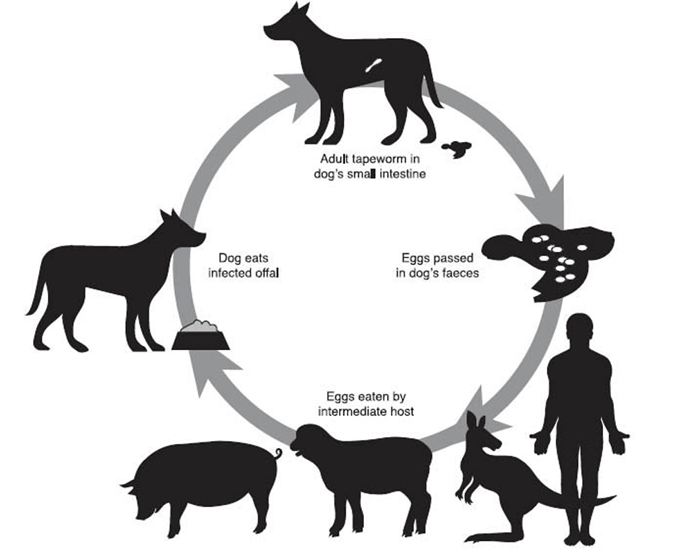Much safer to prevent than cure
The Safest Parasite Control for Dogs
Parasites can be deadly in dogs and some of them can even cross over into humans. For these important reasons, it is much safer to prevent them from affecting your dog than treating the diseases they cause.
Our recommended dog parasite control protocol is as follows:
| Product name | Frequency | Prevents |
| Proheart injection | Annually | Heartworm |
| Bravecto oral chew | Quarterly | Ticks and fleas |
| Seresto tick collar | 4-monthly | Ticks and fleas |
| Milbemycin* tablet or Drontal oral chew | Quarterly | Intestinal worms |
* Either Milpro/Milbemax brands are recommended
For extra tick prevention, we also advise your dog wears a Seresto collar and a new one is applied every 4 months.
When these products are purchased from Turramurra Veterinary Hospital, a reminder via text message is sent when your dog is next due.
If you have difficulty administering these products to your dog, our nurses are highly skilled in medication administration to even the most stubborn jaw clampers and tablet resisters out there. You are welcome to book your dog in for a complimentary nurse consultation if you purchase your dog’s parasite control at Turramurra Veterinary Hospital (provided your dog is friendly).
Which parasites can affect my dog?
Dog parasites can either be internal (endoparasites) or external (ectoparasites).
Internal parasites
The most common internal parasites are worms that live inside your dog either in the gastrointestinal tract (stomach and intestines) or cardiovascular system (blood, heart and large vessels).
Intestinal worms
There are five different intestinal worms seen in dogs that need to be eliminated through regular parasite control:
- Roundworm (Toxocara canis)
- Whipworm (Trichuris vulpis)
- Hookworm (Ancylostoma caninum)
- Flea tapeworm (Dipylidium caninum)
- Hydatid tapeworm (Echinococcus granulosus)
Roundworms infect puppies in utero via the placenta, whereas hookworms are acquired by puppies during nursing. Adult dogs can also acquire roundworm or hookworm infections. Whipworm infection occurs via whipworm egg ingestion from environmental contamination.
Children in contact with dogs infected with roundworm or hookworm or a contaminated environment can develop serious health conditions including skin lesions, liver infections, intestinal problems, nerve damage or even blindness.
Hydatidosis in humans is a serious zoonotic disease and is caused by the Hytatid tapeworm. See below for further information about the risks of Hydatid tapeworm in people.
Other common internal parasites in dogs are microscopic and include coccidia, giardia and cryptosporidium. These parasites are treated if detected on faecal parasite screening, such as when your dog develops diarrhoea. Our in-house laboratory includes a Vetscan Faecal Imagyst Analyser, which detects parasites using artificial intelligence via a specialised microscope.
Heartworm
Heartworm (Dirofilaria immitis) is transmitted by mosquitoes. Once the larvae form enters the bloodstream, within 6 months, they develop into adult worms which reside in the heart and major vessels, causing potentially fatal heart failure if left untreated. Heartworm prevention targets the microfilaria (larval form of the parasite) so that no adult worms develop in your dog.
External parasites
The main parasites we are referring to are fleas and ticks. Other external parasites such as mites and lice are less common in dogs.
Fleas
Fleas are common parasites that can cause problems such as allergic skin disease, blood-borne parasite infection and flea tapeworm infection. In young puppies, a heavy flea burden can cause severe blood loss and be life-threatening.
Ticks
Tick toxicity is a common condition caused by the Australian paralysis tick, Ixodes holocyclus. This tick is far more deadly for pets than ticks elsewhere in the world, because they produce a neurotoxin in their saliva, which can kill a dog within 5 days of attachment. This tick is fairly unique to Eastern Australia and more common the closer you get to the coast. The natural hosts are possums and bandicoots. The paralysis tick is on the move and has more recently been affecting pets as far inland as the Blue Mountains. Click here for further information on tick toxicity.
In the far north of Australia, a newly introduced tick-borne illness known as Ehrlichiosis, caused by the bacteria, Ehrlichia canis, is causing numerous deaths throughout far north Queensland and the Northern Territory. This bacteria is found in a different species of tick known as the brown dog tick, Rhipicephalus sanguineus. This fatal illness will continue to affect dogs in other more southern parts of Australia over time as the brown dog tick spreads. Discover more on Ehrlichia canis (e-canis) here.
Why is Bravecto chew the best tick preventative for my dog?
Given the high fatality rate of tick toxicity in dogs in our local area, Turramurra Veterinary Hospital’s preferred parasite control protocol for dogs includes giving a Bravecto chew every 3 months because it is the most reliable life-saving tick preventative available. Research has shown that owners are often several days late in giving preventative products but with Bravecto chew, even if the owner is late giving it to their dog, as the active ingredient, fluralaner, is longer acting than the other available oral tick treatments on the market.
We frequently see tick toxicity in pets on monthly tick control products where there is a lapse of several days, because the active ingredient is shorter acting, so there is less room for error.
We are all only human, and so in our opinion, Bravecto oral chews are the safest for your dog and saves the most lives.
Bravecto should be given with food for improved absorption and to reduce the potential for vomiting.
Having to give your dog parasite control 4 times per year compared to 12 times per year is a lot less hassle as well.
If you are travelling to Far North Queensland or Northern Territory with your dog, increase the frequency of Bravecto to every 2 months to cover brown dog ticks and bush ticks and always use a Seresto tick collar.
Should I use a tick collar as well as an oral tick preventative?
For extra protection in both dogs and cats, use a Seresto tick collar to help repel ticks.
In conjunction with the Bravecto chew, a Seresto collar can be worn, which acts as a repellent to ticks, but should not be relied upon by itself. A Seresto collar lasts 4 months and helps prevent tick bites and tick-borne parasites in your pet.
What about other tick preventatives on the market?
For monthly tick preventative products such as Nexgard or Simparica, we recommend setting your reminder system up every 4 weeks (28 days) to ensure you are not late administering these products. It is safer giving a monthly preventative several days early than several days late.
Bravecto spot-on is an alternative topical tick and flea preventative product available for your dog, which can be applied every 3 months (off-label use) instead of the chew, but in our experience, the chew is more reliable as a tick preventative product. The topical product is an option for dogs that refuse to eat the chew or cannot tolerate it.
I prefer to give my dog a monthly preventative – what should I use?
Turramurra Veterinary Hospital’s preferred monthly parasite control protocol is as follows:
| Product name | Frequency | Prevents |
| Simparica oral chew | Monthly | Ticks and fleas |
| Interceptor oral chew | Monthly | Intestinal worms and heartworm |
Interceptor has complete intestinal worming cover, including a tapeworm treatment (praziquantel), which many products do not. Turramurra Veterinary Hospital stocks both Interceptor and Simparica.
Is there any parasite control product that covers everything my dog needs?
No. Not yet anyway.
Many people purchase monthly parasite control for their dog that claims to have “the most complete parasite control”. This may be confusing for dog owners as they are unaware that in fact the product(s) they are using for their pet either doesn’t include any tapeworm prevention (Nexgard Spectra or Simparica Trio) or tick control (Sentinel Spectrum).
I frequently recommend that a quarterly tapewormer is added in to their parasite control regime or inform clients that they need tick control added in due to the risks in our local area of tick toxicity.
Should I be concerned about tapeworm in my dog?

Hydatid tapeworm is a public health concern because it is a zoonosis – a disease that can infect humans.
As the hydatid tapeworm can cause serious disease in humans, this is definitely a parasite that needs to be included in your chosen parasite control regime.
There are two common tapeworms that can affect dogs – the flea tapeworm and the hydatid tapeworm. The flea tapeworm is uncommon if your dog is on a regular flea preventative and rarely causes problems in people. On the other hand, the hydatid tapeworm can pose a serious health risk in people of all ages.
Hydatid tapeworm infection in dogs
Dogs (as well dingoes or foxes) can become infected with the hydatid tapeworm only if they swallow a tapeworm head. These can originate from cysts contained in offal (organs) they eat, or eating undercooked or raw meat or blood contaminated by cyst fluid when the animal was killed.
Even for dogs that are fed commercial dog diets, there is a risk of consuming a tapeworm head from carcasses of other animals they come across (wallabies, kangaroos, sheep, cattle).
So, for suburban or rural dogs, using an intestinal wormer that covers tapeworm with a product containing praziquantel is important.
Hydatidosis in humans
Hydatidosis (also known as Cystic Hydatid Disease or CHD) is caused by the Hydatid tapeworm tissue cysts and is a zoonotic disease that poses a threat to human health.
People become infected by ingesting (swallowing) the tapeworm eggs from an infected dog. This can occur via hand-to-mouth transfer after handling dogs or objects contaminated with the eggs, or from consuming contaminated food or water.
The larval form of the tapeworm may lodge in various body sites (most commonly the liver or lungs) where they form a fluid-filled sac known as a hydatid cyst. The cysts can increase in size from 5–15 cm over a long period of time, sometimes requiring surgical intervention. While some cysts may die, others can remain alive for decades. Tissue cysts also contain ‘daughter cysts’ which may spread to other parts of the body. The disease appears as a result of the slow growth of the cysts over time, so infection acquired during childhood often does not appear until later in life, most commonly between 30-50 years of age.
References:
King S, Hutchinson, G (2007) Hydatids – you, too, can be affected. NSW DPI Primefact 475.
Queensland Government (2017) Hydatid Disease. Infections and Parasites.
Government of Western Australia (2017) Hydatid Disease. Dept of Primary Industries and Regional Development.


